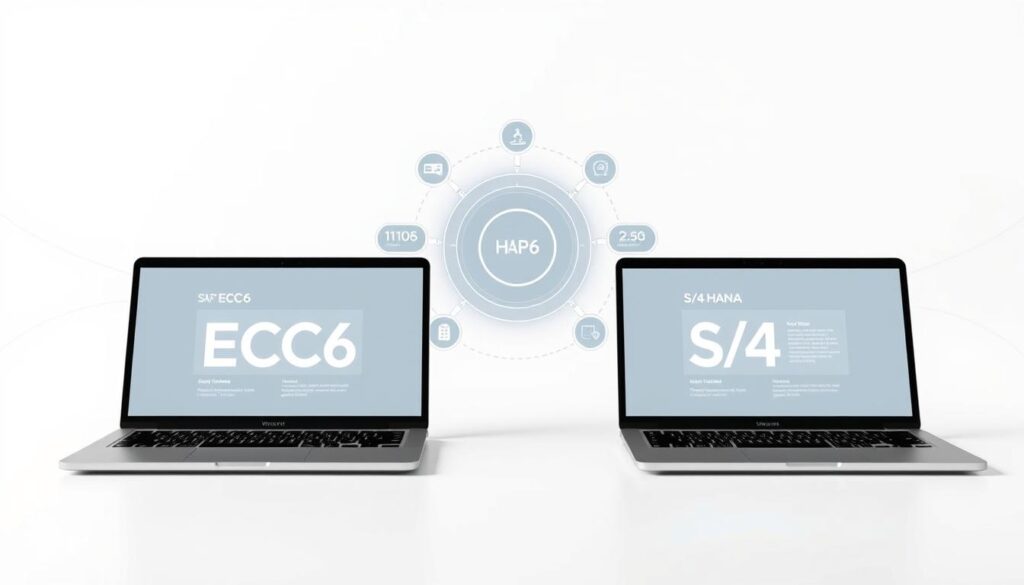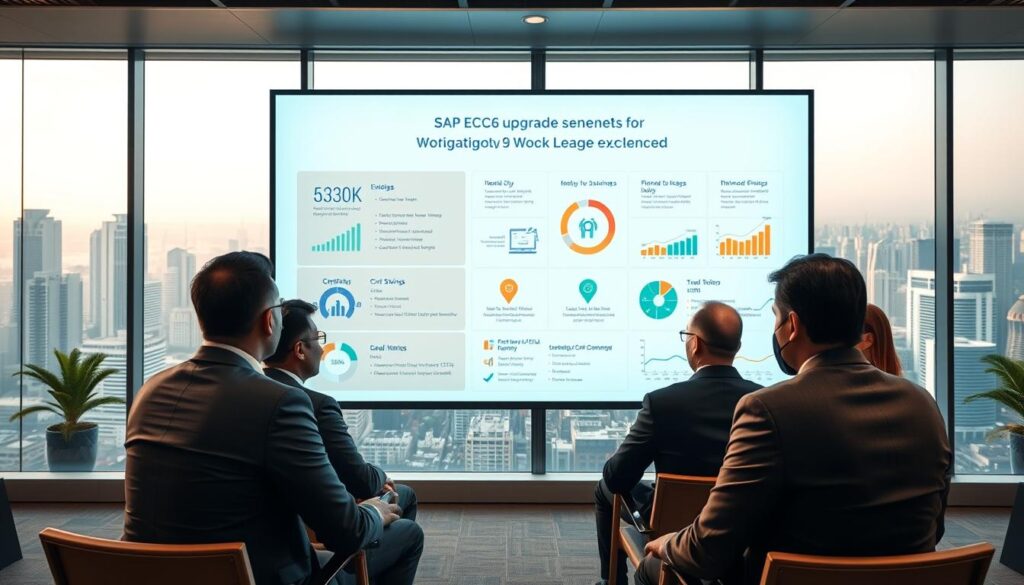Indian enterprises are navigating a critical digital transformation landscape with SAP ECC6 upgrade solutions becoming increasingly essential. As the 2027 maintenance deadline approaches, organisations across manufacturing, pharmaceuticals, IT services, and retail sectors must strategically plan their enterprise resource planning modernisation.
The SAP ECC6 upgrade in India represents more than a technological shift; it’s a comprehensive business evolution. Businesses require a nuanced understanding of migration pathways, technological capabilities, and strategic implementation frameworks to successfully transition to S/4 HANA.
This migration guide provides Indian businesses with a comprehensive roadmap, addressing technical complexities, strategic planning, cost considerations, and implementation challenges specific to the local market ecosystem.
Key Takeaways
- Understand the critical 2027 SAP maintenance deadline
- Recognise technological differences between ECC6 and S/4 HANA
- Develop a structured migration strategy
- Evaluate infrastructure and resource requirements
- Mitigate potential implementation risks
Understanding the Differences Between SAP ECC6 and S/4 HANA
Indian businesses seeking digital transformation are increasingly exploring sap ecc6 migration services to modernise their enterprise resource planning systems. The transition from SAP ECC6 to S/4 HANA represents a significant technological leap that goes beyond simple software upgrades.

Enterprise resource planning technologies are rapidly evolving, presenting organisations with complex migration challenges. SAP’s strategic shift from traditional ECC6 to the next-generation S/4 HANA platform offers unprecedented technological capabilities for businesses looking to streamline their digital infrastructure.
Architectural Transformation
The fundamental architectural differences between ECC6 and S/4 HANA are profound. While ECC6 operated on traditional client-server architectures, S/4 HANA represents a radical reimagining of enterprise software design. This new approach eliminates redundant data tables, reducing overall system complexity and data footprint by up to 75%.
Database and Computing Innovation
SAP HANA’s in-memory computing platform revolutionises data processing capabilities. Traditional disk-based databases are replaced with real-time analytics engines that dramatically accelerate transaction processing. Indian businesses can now generate complex reports in seconds rather than hours, enabling faster decision-making and operational agility.
User Experience Revolution
The user interface transformation is equally significant. Moving from the traditional SAP GUI to the modern, responsive SAP Fiori interface provides role-based, intuitive interactions across desktop and mobile platforms. This design philosophy directly addresses the needs of India’s dynamic and increasingly mobile workforce.
Why Indian Businesses Are Moving from ECC6 to S/4 HANA

Indian businesses are rapidly embracing SAP S/4 HANA to transform their digital infrastructure. The sap ecc6 upgrade benefits are driving strategic decisions across multiple sectors, responding to the critical 2027 end-of-maintenance deadline for ECC6.
Digital transformation has become a primary catalyst for migration. S/4 HANA offers Indian organisations advanced analytics, real-time financial consolidation, and improved supply chain visibility. These sap ecc6 upgrade benefits directly support India’s Digital India programme and Industry 4.0 initiatives.
Regulatory compliance represents another significant driver. The new platform simplifies GST reporting, enhances audit trails, and provides robust support for Indian localisation requirements. Businesses can now process higher transaction volumes during peak periods, such as festival seasons, with unprecedented efficiency.
Cost reduction emerges as a key advantage. S/4 HANA enables simplified IT landscapes, reduced total cost of ownership, and greater operational agility. Manufacturers, retailers, and service providers are witnessing substantial improvements in data-driven decision-making capabilities.
The transition represents more than a technological upgrade—it’s a strategic business transformation enabling Indian enterprises to compete effectively in a rapidly evolving digital ecosystem.
SAP ECC6 Upgrade India: Planning Your Migration Strategy
Navigating the SAP ECC6 upgrade process requires strategic planning and careful consideration for Indian businesses. Organisations across India are increasingly recognising the critical importance of modernising their enterprise resource planning systems to stay competitive in a rapidly evolving digital landscape.
The SAP ECC6 upgrade journey begins with a comprehensive evaluation of your current technological ecosystem. Understanding your existing system’s strengths, limitations, and potential areas for improvement is crucial for a successful migration strategy.
Assessing Your Current ECC6 Environment
Conducting a thorough system landscape analysis forms the foundation of the sap ecc6 upgrade process. This involves mapping existing integrations, evaluating custom code complexity, and identifying potential challenges specific to Indian business environments. Companies must scrutinise their current SAP ECC6 infrastructure, examining data volumes, third-party system connections, and operational workflows.
Building a Business Case for Migration
Developing a robust business case requires quantifying both tangible and intangible benefits of the sap ecc6 upgrade india strategy. Decision-makers need to understand potential cost savings, improved operational efficiency, and strategic advantages that come with modernising enterprise systems.
Selecting the Right Migration Approach
Indian organisations have three primary migration paths: Greenfield (complete reimplementation), Brownfield (system conversion), and Bluefield (selective data transition). Each approach offers unique advantages, and the selection depends on specific business requirements, budget constraints, and digital transformation goals.
Common Pitfalls to Avoid During ERP Migration
Navigating an ERP migration can be treacherous for Indian businesses. SAP ECC6 migration services require careful planning and strategic execution to avoid critical mistakes that could derail the entire digital transformation journey.
One significant pitfall is underestimating the complexity of custom code remediation. Many Indian organisations have developed intricate, localised systems over decades. These bespoke solutions often require extensive refactoring during migration to S/4 HANA, demanding rigorous technical assessment and strategic code management.
Change management represents another crucial challenge. Technical success means little if users resist the new system. Developing comprehensive training programmes tailored to India’s diverse workforce becomes paramount. This involves creating intuitive learning modules that address varying levels of technological literacy and organisational roles.
Data quality stands as a critical consideration in sap ecc6 migration services. Transferring problematic data simply perpetuates existing challenges. Organisations must implement robust data cleansing initiatives before migration, ensuring clean, structured information flows into the new system.
Budget and timeline underestimation can critically impact migration success. Indian enterprises must develop realistic project plans accounting for organisational complexity, resource constraints, and potential unexpected challenges. Treating migration as a comprehensive business transformation—not merely an IT project—ensures holistic strategic alignment.
Securing skilled SAP resources remains a strategic imperative. India’s competitive technology talent market demands proactive recruitment and retention strategies to support successful ERP migration efforts.
Cost Considerations and ROI for S/4 HANA Implementation
Navigating the financial landscape of SAP ECC6 upgrade costs requires strategic planning and careful analysis. Indian businesses contemplating digital transformation must understand the comprehensive financial implications of migrating to S/4 HANA.
The investment in S/4 HANA encompasses multiple financial dimensions that organisations must carefully evaluate. While initial implementation expenses might seem substantial, the long-term strategic benefits often outweigh the upfront sap ecc6 upgrade cost.
Initial Investment and Licensing Expenses
SAP ECC6 upgrade costs vary significantly based on organisational size and complexity. Licensing models range from traditional on-premise deployments to flexible cloud subscriptions. Small to medium enterprises in India can expect investment ranges between ₹50 lakhs to ₹2 crores, depending on specific business requirements and chosen implementation approach.
Infrastructure and Resource Requirements
Migrating from legacy systems involves substantial infrastructure considerations. Cloud-based solutions are increasingly attractive for Indian businesses, offering reduced hardware investments and scalable resource allocation. The sap ecc6 upgrade cost must factor in potential cloud subscription models, which can provide more predictable expenditure structures.
Long-Term Benefits and Cost Savings
Strategic investments in S/4 HANA deliver measurable returns through enhanced operational efficiency, reduced maintenance expenses, and improved real-time business insights. Most Indian organisations can anticipate investment payback within 3-5 years, making the digital transformation a compelling financial proposition.
Choosing the Right SAP Implementation Partner in India
Selecting the right SAP ECC6 implementation company is a critical decision for Indian businesses undertaking digital transformation. The success of your S/4 HANA migration heavily depends on choosing experienced sap ecc6 upgrade consultants who understand your specific industry challenges.
When evaluating potential sap ecc6 upgrade service providers, prioritise partners with proven expertise in your sector. Look for SAP partnership credentials such as Gold or Platinum status, which demonstrate a track record of successful implementations. Indian organisations should assess potential partners based on their local presence, industry-specific knowledge, and ability to provide comprehensive support.
Key evaluation criteria include reviewing case studies, checking client references, and understanding the partner’s migration methodology. Assess their resource pool to ensure they can staff your project with experienced consultants rather than junior team members. Consider partners offering end-to-end services, from initial implementation to ongoing support and continuous improvement.
Examine the partner’s approach to knowledge transfer and their capability to build internal capabilities within your organisation. Compare different commercial models, including fixed-price and time-and-materials approaches, to find the most suitable option for your business needs.
Ultimately, the right SAP implementation partner will act as a strategic ally, guiding your organisation through the complex migration process while minimising disruption and maximising technological potential.
Conclusion
Migrating from SAP ECC6 to S/4 HANA represents a critical strategic transformation for Indian businesses seeking technological advancement. The journey demands careful planning, robust assessment, and a forward-looking approach to enterprise resource management. SAP ECC upgrade solutions offer organisations an opportunity to modernise their technological infrastructure and unlock unprecedented operational efficiency.
Indian enterprises must recognise this migration as more than a technical upgrade—it is a strategic business reinvention. By embracing S/4 HANA, companies can leverage advanced analytics, streamline processes, and position themselves competitively in an increasingly digital marketplace. The 2027 maintenance deadline creates urgency, but organisations should prioritise thoughtful implementation over rushed transitions.
Successful migration requires comprehensive preparation, including detailed system assessment, building a compelling business case, and selecting experienced implementation partners. SAP ECC upgrade solutions enable businesses to eliminate technical debt, enhance decision-making capabilities, and prepare for emerging technologies like artificial intelligence and machine learning.
As Indian organisations navigate this technological shift, the key is to view S/4 HANA not as an expense but as an investment in future-proofing their enterprise. By approaching the migration strategically, businesses can transform their operational landscape, drive innovation, and create sustainable competitive advantages in India’s dynamic economic environment.

